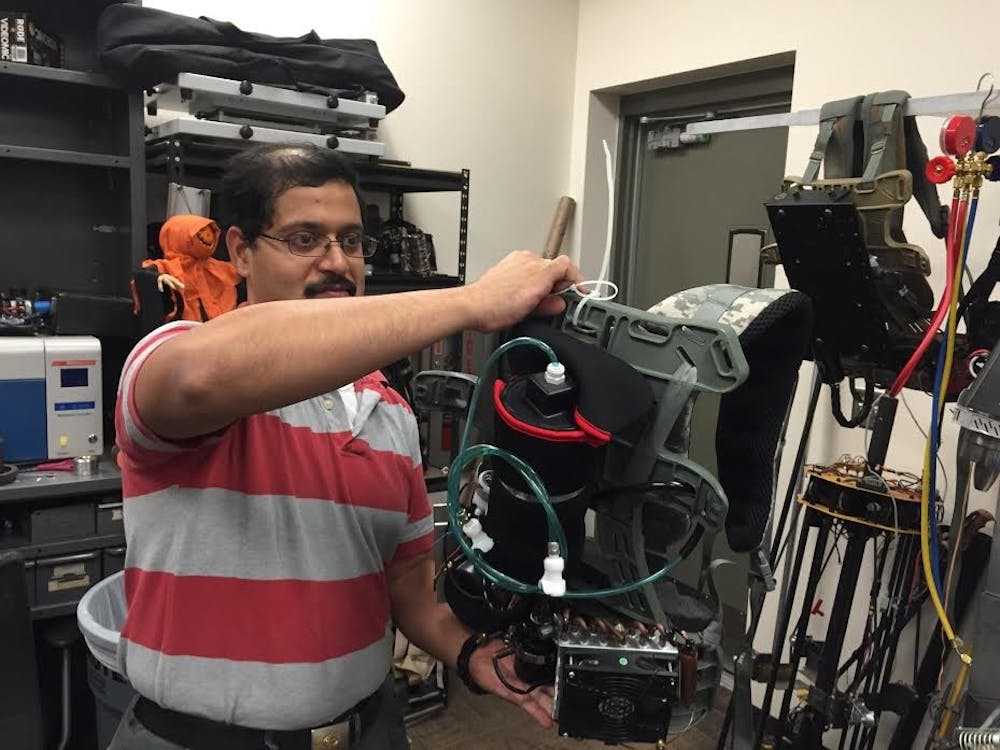Jetpacks. Robotic tendons. ‘Spider-Man’ suits.
The work of ASU’s Human Machine Integration Lab sounds like something straight from a sci-fi novel, but for the small group of students and professors, it’s all in a day's work.
Tucked away in a small Polytechnic classroom, one would expect to walk in and see a Tony Stark-esque lab, complete with shining, indecipherable tools and hovering dioramas.
But the lab's director Thomas Sugar, engineering professor Sangram Redkar and their team of six engineering students, resembled more of a mixture between a scene from "Good Will Hunting" and an episode from "Dexter’s Laboratory."
Multicolored cords were splayed across the room, complex math algorithms were scrawled on a whiteboard that stretched across the room and prototypes lay casually on desks surrounded by tools.
No, the room did not look like the product of a Marvel movie. Yet, the group of students sitting in the classroom had created something more poignant than an Iron Man suit.
“We want to make an impact,” Redkar said. “We want to excel, we want to reach out to people, we want to make an impact in society by means of education, research, improving the quality of life and making the community and world a better place.”
The lab started in 2010 with Sugar who’s primary goal was to design robots that interact with people. Sugar built a team, which is lead by Redkar, started off creating projects that addressed issues they thought they could help.
They began their original projects focusing on things like stroke rehabilitation and building powered ankles for below-the-knee amputees.
However, as the program grew and they began working with the U.S. military to design prototypes, the designs got more and more complex.
It was in the past year-and-a-half that the lab took off, especially when they began working on a device for a project called the "4 Minute Mile." The idea was to enable an average soldier, packed with gear, to be able to run a four minute mile — an average speed of 15 mph.
The draw of the device, and what seemed to draw eyes to the lab was the name — “Jetpack.”
Although it wasn’t the traditional shoot-you-up-into the air sort of device, the suit used a thrust to push the runner forward.
Read more: ASU student develops 4MM jetpack that blows people away
For Redkar and students like electrical engineering graduate student Nico Radda, the idea behind the pack was the thing that created a gap between the stuff you see in action movies and their personal reality.
“For me, it was the development of systems that interact with people that sparked my interest," Radda said. "So being able to create projects that help people move or make life more comfortable through technology is amazing.”
They said that they hoped the jetpack would be used for situations where soldiers need to get in and out of dangerous areas quickly. It was less about the flashiness and more about the potential of saving lives.
After the pack, came product design junior John Harris’s "Pogo suit." It’s a backpack that, when worn, moves the the load on your back up and down like a pogo stick. So relative to the ground, the load doesn’t change position which allows the wearer to carry infinitely more weight.
Then came the cooler suit, a pack that lowers the body temperature for people like fighter pilots who don’t have things like A/C to cool themselves down at war.
Innovation after innovation, Redkar said the lab cranked out about six different projects a year, usually going to the military.
However, the engineers intend their work to eventually go out into the commercial domain to help people other than just military soldiers.
“Most of the projects we’ve worked on have been for the military,” Harris said. “But what happens is the military gets the technology first, it gets worked out, someone makes a product out of it and it helps the public. That’s the general trend and we’re just starting it now.”
Harris said a few of the projects they’ve worked on have made it into the commercial domain, most dominantly Sugar’s robotic ankle which is now being used for amputees.
However, Harris used the cooling suit as an example. It’s being used for pilots who need a way to cool down. But after it becomes a more commonly-used invention he says they’ll see it be used by firefighters, hazmat teams or even race car drivers who also lack an air conditioner.
They may be working on the projects on grants by the military, but Harris said the inventions usually make their way to the public.
In that sense, while the packs weren’t by any means tricked out Iron Man suits, revolutionizing the military and defense, Redkar and his students all agreed the technology was taking society step-by-step into the future.
“That’s what we do at ASU, right?" Redkar said. "We impact. We create impact.”
Related Links:
ASU engineers debut flexible electronics prototype
Reach the reporter at megan.janetsky@asu.edu or follow @meganjanetsky on Twitter.
Like The State Press on Facebook and follow @statepress on Twitter.




